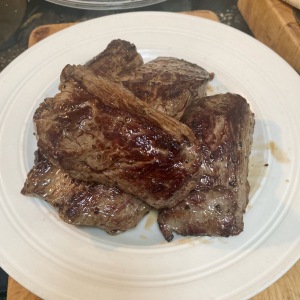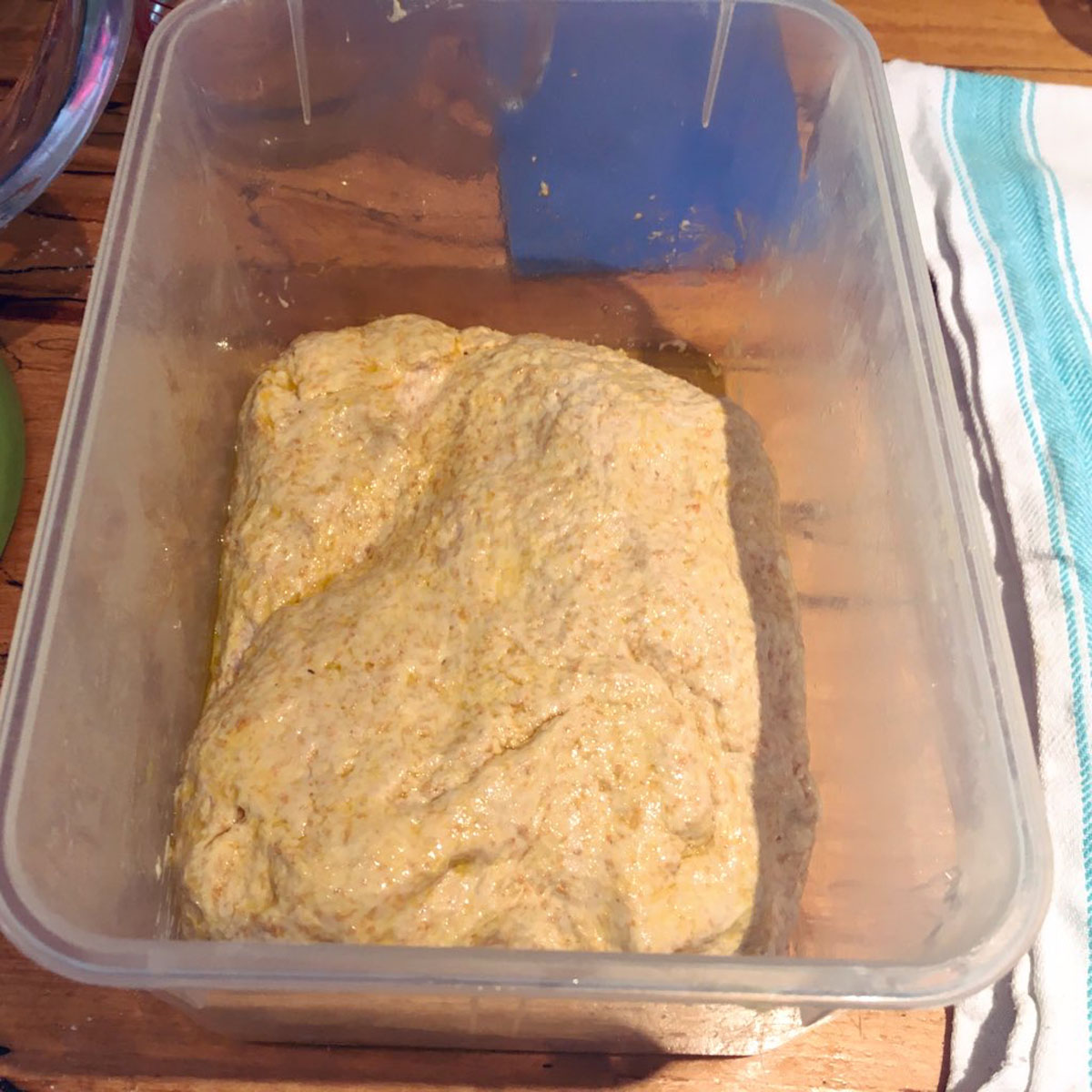I’ve been planning to write up my old-faithful peppercorn sauce recipe for ages but it never quite felt like it deserved its own blog post (harsh, for an old standard of mine, thank goodness recipes don’t have feelings!). And then the lovely people at Swaledale Butchers offered to send me some of their meat to try and it seemed like a combination made in heaven, because I get to talk about one of my favourite butchery cuts, the bavette steak, a French standard but sadly hard to come by in UK, and share my favourite peppercorn sauce recipe with you into the bargain.
We had visitors last weekend so my dinner plan worked perfectly, almost everything can be prepared ahead of time leaving just the steaks to fry off in a good pan to medium rare, with a good long rest afterwards during which all the last little fiddly bits can come together. I served the steaks with a rich creamy peppercorn sauce, a very traditional French-style tomato salad, a herby green rocket salad, and oven chips.
You can do most of the work on the sauce before the steaks go anywhere near the pan, which really takes the pressure off multitasking at the last minute and over-doing the meat by accident. So do this first, until the mix is reduced by half, and then take the pan off the heat.
Bavette steaks are a favourite of mine and I can be depended to order them if I find them on a decent bistro menu. Anatomically they come from the area where the lower part of the sirloin joins the flank. They don’t have surface fat but will often have a little marbling within the meat itself. The muscle fibres are relatively loosely joined here and are arranged length-wise in the butchered steak, which means it’s important to slice the steak across the fibres when serving – but if you do that the result is a lovely juicy, buttery mouthful which can easily be tackled without any need for a steak knife.
To cook your steaks to perfection, get them out of the refrigerator a little in advance, pat them dry of any juices, and allow them to come to room temperature. (Make sure they’re covered to keep flies off if that’s a problem where you are!)
These are quite thick steaks and will take longer in the pan than you expect, and benefit from a good period of resting afterwards (ten minutes is a good target). I would ideally cook these medium-rare, medium would probably be OK – if you’re a ‘well-done’ steak person (by choice or by necessity) then bavette probably isn’t the right cut for you.
You want a pan that you can get really, decently hot – this isn’t a job for a non-stick pan, you’re going to burn the non-stick surface if it’s hot enough and if it isn’t, you’re not going to do the steak justice. I have a great carbon steel pan that I bought about three years ago which is slowly developing a good nearly non-stick seasoned surface and this is absolutely perfect for this task.
Season the steaks lightly with just a pinch of salt and pepper immediately before they go in the pan.
I like to fry my steaks in a mix of half butter, half cold-pressed rapeseed oil. Heat the fats until the butter is foaming, and then place the steaks in the pan. Don’t crowd them. They should sizzle immediately. Leave them still for several minutes (I would give the first side five minutes, probably). When you turn them over you should find a lovely golden brown caramelised crust has formed. Give them the same amount of time on the other side and then check for doneness. The best way I have ever been shown of doing this is to check the texture of the steak. It sounds odd but if you press a finger tip into your cheek, and then to your chin, and then to your forehead, that difference in firmness is a good approximation to the difference between a rare (cheek), medium (chin) and well-done (forehead) steak. Depending on the thickness of the steak and your preferences they may well need a few minutes longer. If in doubt, you can always cut into the steak to check (you’ll be slicing them to serve anyway) but bear in mind that they will continue to cook a little while they rest.
If you’re happy, set them aside, covered, somewhere warm, to rest for 10 minutes.
Put the pan with the peppercorn sauce back on the heat and warm it back through. Just before serving, stir in the clotted cream and any juices that have leaked during resting and slicing the steaks, and bring it to the table in a jugs so that people can help themselves.
To serve, slice the steaks across the grain into slices about half an inch thick. Add chips and salads. Pour over the peppercorn sauce. That’s it. Could it be simpler?
For the Peppercorn Sauce (to serve four):
Ingredients:
- 2 small or one large shallots
- Big knob of butter
- 200ml good beef stock
- 1 tbsp roughly ground peppercorns
- 100ml brandy
- 2 good tablespoons of clotted cream
- Salt (to taste, if needed)
Melt the butter in a saucepan.
Finely chop the shallots and cook gently in the butter until soft and translucent (about five minutes)


Add the stock and bring to a simmer. Add the ground pepper.
Add the brandy and start to reduce the stock gently. It will take about fifteen minutes for the brandy to cook off and the volume of the sauce to reduce by half.


(Once it’s reduced by half you can take it off the heat and attend to other things, and continue when the steaks are resting. Warm it back up again before continuing as below.)
Just before serving, add the clotted cream and stir in, reduce the heat and stir gently until you’re ready to serve. Add any juices from the resting plate and from slicing the steaks and stir these in. Taste and season with a little salt if needed, and bring to the table piping hot in a suitable jug or sauce boat.

For the side dishes –
Salade de tomates / Tomato salad
This is the simplest thing in the world. Take good ripe tomatoes, slice them thinly (some people think you should peel them first but I am with my grandmother on this one – life is too darn short to peel tomatoes!) and lay them on a plate, seasoned lightly with just a pinch of salt between layers. Sprinkle over with finely chopped fresh herbs – I used a mixture of parsley, chives and oregano. Serve with a good mustardy vinaigrette to taste.
Herby rocket salad
Because the rocket is growing here and the rest of the salad veg isn’t ready yet – but the peppery punch of good wild rocket goes a treat with the peppercorn sauce. This was just wild rocket, with a few slivers of sorrel, mixed with roughly chopped fresh herbs – the same as above, parsley, chives and oregano, be generous. Add a few rocket flowers if you have them, they taste of vanilla! It likes the same mustardy vinaigrette that suits the tomatoes – handy, that!
A few words about the steaks:
I’ve always openly disclosed any freebies or sponsorship on this blog and that won’t ever change. The steaks were sent to me FOC to review, but otherwise Swaledale had no input into the content of this post. There are no affiliate links and I don’t stand to make a penny whether you all decide to go and buy their steaks or not! (You should, though, because they were very good indeed.)
I’m very impressed with Swaledale’s approach to butchery – a focus on locally farmed, traditional breed animals and then using the whole carcass, which is why they offer more unusual – and cost-effective, these steaks cost a fraction of what you’d pay for a sirloin or rib-eye – cuts like the bavette, along with other great options you don’t often see in the UK like onglet, featherblade and spider steaks. The delivery was nicely packed in recyclable materials with lots of ice packs and the meat arrived in perfect condition. Despite (inevitably) being vacuum packed, the bavette steaks caramelised beautifully in the pan.
You can order from Swaledale Butchers here.
Read more from the Country Skills blog >>









 250g plain flour (any other flour will almost certainly also work here as a substitute)
250g plain flour (any other flour will almost certainly also work here as a substitute)


























 3 large cloves of garlic
3 large cloves of garlic




 Now, a little aside, if you don’t mind, about small quantities of cream. I’m always buying cream for this or that recipe, and then the rest goes off in the door of the fridge and eventually gets thrown away. But as it turns out, there’s an alternative. Take any surplus cream you have after cooking with it, and pour it into an ice cube bag (I prefer the bags for this to the open plastic trays, because the cream is fully sealed in them and can’t take on flavours).
Now, a little aside, if you don’t mind, about small quantities of cream. I’m always buying cream for this or that recipe, and then the rest goes off in the door of the fridge and eventually gets thrown away. But as it turns out, there’s an alternative. Take any surplus cream you have after cooking with it, and pour it into an ice cube bag (I prefer the bags for this to the open plastic trays, because the cream is fully sealed in them and can’t take on flavours). Tie the top securely, and freeze. My bags produce cream-cubes of almost exactly 15ml each, conveniently a tablespoon measure. Then, when you need a little bit of cream for a recipe – sauces like this one are a classic example – just take what you need out of the freezer. I don’t think it would whip-up properly after this treatment, but for this kind of use it’s perfect.
Tie the top securely, and freeze. My bags produce cream-cubes of almost exactly 15ml each, conveniently a tablespoon measure. Then, when you need a little bit of cream for a recipe – sauces like this one are a classic example – just take what you need out of the freezer. I don’t think it would whip-up properly after this treatment, but for this kind of use it’s perfect.







 1/4 tsp of honey
1/4 tsp of honey











